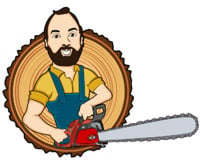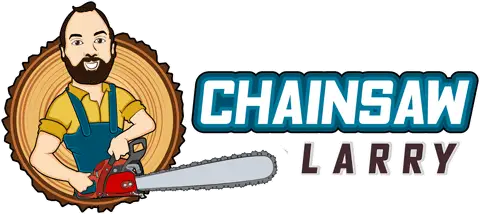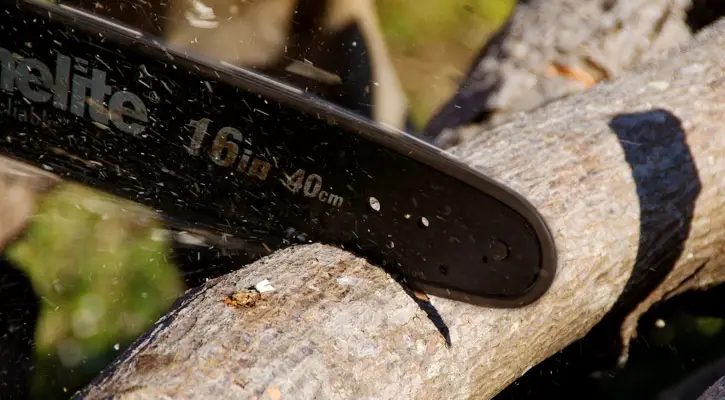Table of Contents
If you’re thinking about buying a chainsaw, then you’re probably wondering what size chainsaw do I need?
With so many different sizes of chainsaws available, it can be hard to know which one to buy.
Should you just go for the longest chainsaw length you can afford or is a shorter chainsaw really a better buy?
To help you find the best chainsaw for your budget, I’ll help you figure out how to select the right chainsaw size for your needs.
By the end, you’ll know exactly which size chainsaw to purchase for the jobs at hand.
So, let’s get into it!
How to Choose the Right Size Chainsaw
The answer to the question, “what size chainsaw do I need?” depends mostly on the length of the guide bar.
The guide bar (or blade) is the metal bar which the chain of the chainsaw rotates around.
The full measurement of the guide bar is often displayed on the side of the blade, in the product manual, or found in the online specifications.
However, if you already own a chainsaw and are unsure of the length, here’s how to measure it:
- Using a tape measure, carefully measure from the tip of the chain at the furthest end of the bar to the base where the guide bar enters the housing of the engine.
- If the measurement is an odd length, just round to the nearest even number, like 14″, 16″, 18″, etc.
The Proper Size for a Chainsaw
A basic guide is that the chainsaw should be at least 2 inches longer than the thickness of whatever branch or tree is being cut.
For example, if the branch is 8 inches thick, the guide bar (or blade) of the ideal chainsaw should be at least 10 inches long. This ensures that the wood can be cut through in one easy pass.
Another factor when considering the size of the chainsaw is the power of the engine.
Typically, the power of the engine is proportional to the length of the guide bar. Meaning, the longer the guide bar, the more powerful the engine is to support it.
Most chainsaws allow you to swap out the blade for a longer or shorter piece; however, you don’t want to go more than one step up in the guide bar that’s supplied with the tool.
The reason being is that the engine may not be able to support a guide bar longer than two additional inches than the blade from the manufacturer.
Recommended Chainsaw Sizes for Each Task
For the safest cutting, every woodcutting task calls for a specific length of a chainsaw blade.
Below, are the recommended chainsaw sizes for each type of job.
When you’re done reading this section, be sure to check out my free guides that can help you select the best chainsaw for your needs.
- If you want to see what the top 10 chainsaws are for every size, view my best rated chainsaws list.
- For the top all around chainsaws check out my best all around chainsaws guide.
Pruning limbs – 6″ to 10”
If most of your chainsaw needs involve pruning small branches or trees with relatively thin branches, a 6″ to 10” chainsaw is the tool for the job. However, if the branches are only a couple of inches thick, or even thinner than that, a small handsaw may be more appropriate for the task.
Also see my best small chainsaw guide.
Removing branches – 8” to 12”
When removing branches from larger trees at home, the branches are often about 6-10” thick. Thus, your guide bar should be at least 8″ to 12” long to make the task quick and painless.
Also see my best cheap chainsaw guide.
Felling small trees – 12” to 14”
Cutting down small trees in a yard or garden will require a chainsaw of about 12″ to 14” depending on the thickness of the tree trunk.
Also see my best homeowner chainsaw guide.
Splitting firewood – 14″ to 16”
When splitting logs into firewood, a chainsaw of about 14″ to 16” will usually do the trick, unless the logs you are cutting are very large.
Also see my best chainsaw for firewood guide.
Felling medium trees – 16” to 18”
Cutting down medium size trees with a trunk of about 14″ to 16” will require a larger chainsaw of about 16″ to 18” to fell the tree in one easy pass.
Also see my best 16 inch chainsaw and my best 18 inch chainsaw guides.
Felling large trees – 20″ and larger
Cutting down larger trees is a task that’s often best left to the professionals. However, if you have chainsaw experience and can safely handle a larger chainsaw, you want a guide bar that’s at least 20” long.
More Chainsaw Buying Guides:
If Your Chainsaw Size is Too Long:
It may seem like the best solution is to buy a large chainsaw so that it’ll be prepared to handle any sawing need that arises.
But using a chainsaw that’s too long for the task can be dangerous.
Just a few inches too long is typically no problem but larger saws have increased vibration and greater weight that can be difficult to manage.
For simpler, detailed work, it’s important that your chosen chainsaw be a manageable size to allow you to cut or prune just what needs to be removed and nothing else.
Additionally, kickback is more likely to occur with longer chainsaws. Kickback is when the chain rotation is blocked causing the chainsaw to “kick back” towards the chainsaw operator.
For these reasons, avoid purchasing or using a chainsaw that’s too long for the task. Save money by purchasing the appropriate size from the get-go.
If Your Chainsaw Size Is Not Long Enough:
On the other hand, you may notice that your chainsaw is not the recommended two inches longer than the wood you need to cut.
However, it’s still possible to successfully use a chainsaw that’s smaller than the diameter of the wood. In this instance, it’ll just take a few passes to cut through completely rather than just one pass from the longer chainsaw.
Using a chainsaw that’s too small will involve cutting from opposite directions on one side of the tree rather than starting at one side and cutting all the way through.
If the diameter of the wood is still thicker than double the length of your chainsaw, then that chainsaw may not be up for the task.
In this case, where the chainsaw is far too small for the task, it’s time to consider purchasing a larger chainsaw to simplify the job or hiring a professional who’s able to safely complete the large project.
What Size Chainsaw Do You Need?
As you discovered, the answer to the question, “What size chainsaw do I need?” really depends on the job at hand.
If you’re cutting small branches, then you’ll want a smaller chainsaw, and if you’re cutting down thick trees, then you’ll want a larger chainsaw.
As a reminder, if you’re in the market to buy a new chainsaw, be sure to visit my free buying guides.
I have three, in particular, you may find useful.
For the top 10 chainsaws in every size, view my best rated chainsaws list.
For the top all around chainsaws, see my best all around chainsaws guide.
And for cutting firewood, here’s my best chainsaw for firewood page.
Happy sawing!

Your pal,
Chainsaw Larry

